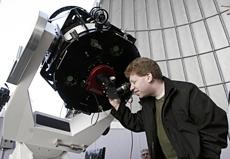If an asteroid 300 meters wide hit off the coast of California, it would create a tsunami big enough to flood the entire west coast. UA astronomers, who lead the world in finding potentially dangerous asteroids, are holding a workshop to help prepare for this type of situation.
Amateur astronomers from around the world will participate in a three-day workshop at Mount Lemmon SkyCenter Thursday through Saturday, to better learn how to observe and track asteroids and near-earth objects.
“”We do know that asteroids hit the earth – just look at the moon it’s covered in craters,”” said Ed Beshore of the Lunar and Planetary laboratory. “”The only reason we don’t see craters on the earth so readily is because we have a climate that slowly grinds them back down.””
As part of the Catalina Sky Survey team, Beshore, along with Steve Larson, will teach classes during the workshop to prepare amateur astronomers on how to track these potentially dangerous objects.
“”We discover hundreds of objects a year and we don’t really have time with our project to do the necessary subsequent precise orbits ourselves,”” Beshore said. “”So we enlist the help of amateurs all over the world.””
Once an object is discovered, the observations are sent to the Minor Planet Center, where they are then added to a list on their Web site, Beshore said. Amateur astronomers can monitor the list and track these objects, and when one is found to be particularly large or a potential threat, additional observations will be made.
“”They are infrequent, but the consequences are so huge that it seems prudent to get an inventory of these objects so that we know if it’s a problem we are going to have to deal with or if it’s no threat,”” Beshore said.
Last October, Mount Lemmon astronomers discovered an object, over North Africa, 20 hours before it hit earth. Beshore said within 20 hours, 500 new observations were made about this object, and most were from amateurs.
“”For the first time ever we actually have an asteroid that we’ve observed in space re-enter the earth and we’ve been able to recover pieces of it on the ground,”” he said. “”Amateurs were an integral part of this process of being able to obtain these observations.””
The asteroid was small, about six feet wide, and caused no damage.
Beshore said some asteroids give astronomers years to decide how to respond, but this one only allowed them 20 hours.
“”Fortunately it was a small object and didn’t really represent a threat but if it was any larger we could have actually got an evacuation going to move people out of the way,”” he said.
The amateurs that participate in tracking these objects are usually working professionals, such as doctors or engineers who are interested in astronomy and want to collaborate with professionals, Beshore said.
Adam Block, the public observing programs coordinator at the SkyCenter, said he thinks the close working relationship between amateurs and professionals will be very beneficial.
“”In astronomy you can have that,”” he said. “”Amateurs can make observations and contributions in real ways, and this workshop caters to that need.””
Vice President of the Tucson Amateur Astronomy Association Keith Schlottman said he plans to take part in the workshop because he believes there is a real threat of an asteroid hitting Earth.
“”It’s happened before and I think it will likely happen again,”” he said. “”If we could be prepared for that in discovering it ahead of time, it increases the chances that we might be able to prepare for it or prevent it.””
Schlottman said he hopes that after taking the workshop, he will be able to participate more in the discovery process of near earth objects.
“”If I’m tracking any objects, or even possibly discover one during any of my own astro-imaging, I would be able to submit the data and contribute in that way,”” Schlottman said.
Beshore said the ultimate goal of this workshop is to teach amateurs how to produce reliable and accurate observations of asteroids.
“”It’s not only useful, it’s really a fun activity that benefits us all,”” he said. “”It helps us do some things that we can’t do on our own.””









